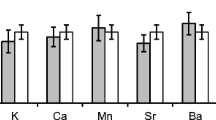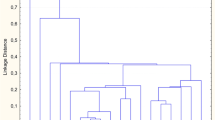Abstract
In this study, copper, zinc, magnesium, manganese, selenium, and iron were measured by inductively coupled plasma atomic emission spectrophotometry in patients with tuberculous (TB) pleurisy (n = 24) and in the control group (n = 20). Selenium, magnesium, and zinc were found to be significantly lower in TB pleurisy cases than those in the control group (p < 0.01, p < 0.001, and p < 0.001, respectively). There was no significant difference in the value of manganese and iron between TB pleurisy and the control group (p > 0.05). Copper levels were significantly increased in the serum of the patients (p < 0.0001). These results may provide an additional disease correlate for assessing TB pleurisy risk.
Similar content being viewed by others
References
Sakuraba M, Masuda K, Hebisawa A, Sagara Y, Komatsu H (2009) Pleural effusion adenosine deaminase (ADA) level and occult tuberculous pleurisy. Ann Thorac Cardiovasc Surg 15(5):294–296
Gopi A, Madhavan SM, Sharma SK, Sahn SA (2007) Diagnosis and treatment of tuberculous pleural effusion in 2006. Chest 1:880–889
Trajman A, Pai M, Dheda K, van Zyl SR, Zwerling AA et al (2008) Novel tests for diagnosing tuberculous pleural effusion: what works and what does not? Eur Respir J 31:1098–1106
Pai M, Flores LL, Hubbard A, Riley LW, Colford JM Jr (2004) Nucleic acid amplification tests in the diagnosis of tuberculous pleuritis: a systematic review and meta-analysis. BMC Infect Dis 4:6
Chen ML, Yu WC, Lam CW, Au KM, Kong FY et al (2004) Diagnostic value of pleural fluid adenosine deaminase activity in tuberculous pleurisy. Clin Chim Acta 341:101–107
Titarenko OT, D’iakova ME, Perova TL, D’iakova AI, Popov MIu (2002) Informative value of adenosine deaminaze and 2-deoxyadenosine deaminase in the diagnosis of tuberculous pleurisy. Klin Lab Diagn 5:11–14 (in Russian)
Sharma SK, Suresh V, Mohan A, Kaur P, Saha P et al (2001) A prospective study of sensitivity and specificity of adenosine deaminase estimation in the diagnosis of tuberculosis pleural effusion. Indian J Chest Dis Allied Sci 43:149–155
Bueso FJ, Hernando VH, Garcia-Buela JP, Juncal DL, Egana MMT et al (1988) Diagnostic value of simultaneous determination of pleural adenosine deaminase and pleural lysozyme/serum lysozyme ratio in pleural effusions. Chest 93:303–307
Ocana I, Martinez-Vazquez JM, Segura RM, Fernandez-De-Sevilla T, Capdevila JA (1983) Adenosine deaminase in pleural fluids. Test for diagnosis of tuberculous pleural effusion. Chest 84:51–53
Chunchao H, Junhua Y, Yingzi W, Lingjun L (2006) Hypoglycemic activity of fermented mushroom of Coprinus comatus rich in vanadium. J Trace Elem Med Biol 20:191–196
Han C (2009) Comparison of anti-hyperglycemic effect of inorganic constituents and organic in traditional Chinese medicine, Jinqi compound recipe. Biol Trace Elem Res 131(1):55–61
Parr RM, Taylor DM (1964) The concentrations of cobalt, copper, iron and zinc in some normal human tissues as determined by neutron-activation analysis. Biochem J 91:424
Charles B, Clayman (1989) American medical association. Am Med Assoc/Encycl Med 396:605–752
Muralidhar LH (2004) Serum trace element levels and the complexity of inter element relations in patients with Parkinson’s disease. J Trace Elem Med Biol 18:163–171
Christianson DW (1991) Structural biology of zinc. Adv Protein Chem 142:281–355
Celik HA, Aydin HH, Ozsaran A, Kilincsoy N, Batur Y, Ersoz B (2002) Trace elements analysis of ascitic fluid in benign and malignant diseases. Clin Biochem 35(6):477–481
Vallee B, Coleman J, Auld D (1991) Zinc fingers, zinc clusters, and zinc twists in DNA-binding protein domains. Proc Natl Acad Sci U S A 88:999–1003
Vallee B, Falchuk K (1993) The biochemical basis of zinc physiology. Physiol Rev 73:79–118
Han C, Li J, Hui Q (2008) Determination of trace elements in Jinqi, a traditional Chinese medicine. Biol Trace Elem Res 122(2):122–126
Blanchard R, Cousins R (1996) Differential display of intestinal mRNAs regulated by dietary zinc. Proc Natl Acad Sci U S A 93:6863–6868
Chesters J, Petrie L, Travis A (1990) A requirement for Zn2+ for the induction of thymidine kinase but not ornithine decarboxylase in 3 T3 cells stimulated from quiescence. Biochem J 272:525–527
Pekarek RS, Wannemacher RW Jr, Beisel WR (1972) Effect of leukocytic endogenous mediator (LEM) on the tissue distribution of zinc and iron. Proc Soc Exp Biol Med 140:685–688
Beyenbach KW (1990) Transport of magnesium across biological membranes. Magnes Trace Elem 9:233–254
Williams RJP (1970) The biochemistry of sodium, potassium, magnesium and calcium. Q Rev Chem Soc 24:331–365
Schrauzer GN, Rhead WJ, Evans GA (1973) Selenium and cancer. Chemical interpretation of a plasma cancer test. Bioinorgan Chem 2:329–340
Shamberger RJ, Rukovena E, Longfield AK, Tytko SA, Deodher S, Willis CE (1973) Antioxidants and cancer. I. Selenium in the blood of normals and cancer patients. J Nat Cancer Inst 50:863–870
Author information
Authors and Affiliations
Corresponding author
Rights and permissions
About this article
Cite this article
Wang, GQ., Lin, MY. Serum Trace Element Levels in Tuberculous Pleurisy. Biol Trace Elem Res 141, 86–90 (2011). https://doi.org/10.1007/s12011-010-8722-1
Received:
Accepted:
Published:
Issue Date:
DOI: https://doi.org/10.1007/s12011-010-8722-1




